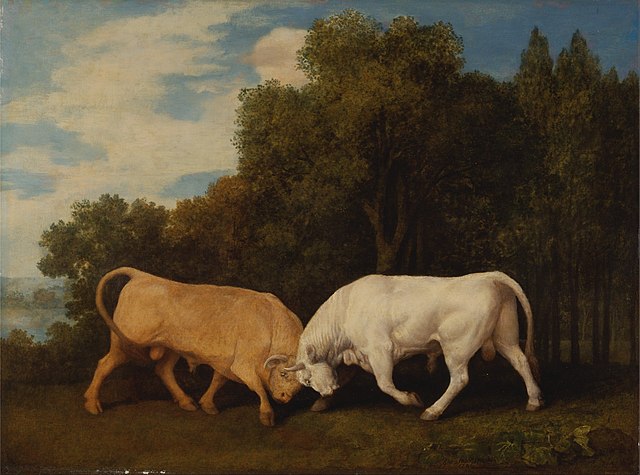2 Bulls Fighting Details
Spanish-style bullfighting is called corrida de toros (literally "running of bulls") or la fiesta ("the festival"). In the traditional corrida, three matadores, each fight two bulls, each of which is between four and six years old and weighs no less than 460 kg (1,014 lb) Each matador has six assistants—two picadores ("lancers on horseback") mounted on horseback, three banderilleros – who along with the matadors are collectively known as toreros ("bullfighters") – and a mozo de espadas ("sword page"). Collectively they comprise a cuadrilla ("entourage"). The word "matador" is only used in English, whereas in Spanish the more general "torero" is used and only when needed to distinguish the full title "matador de toros" is used.
Start of tercio de varas: polished verónica and larga serpentina during a goyesca corrida.
Welcoming of a toro a porta gayola and series of verónica terminated by a semi-verónica.
The modern corrida is highly ritualized, with three distinct stages or tercios ("thirds"), the start of each being announced by a bugle sound. The participants first enter the arena in a parade, called the paseíllo, to salute the presiding dignitary, accompanied by band music. Torero costumes are inspired by 17th century Andalusian clothing, and matadores are easily distinguished by the gold of their traje de luces ("suit of lights") as opposed to the lesser banderilleros who are also called toreros de plata ("bullfighters of silver"). Next, the bull enters the ring to be tested for ferocity by the matador and banderilleros with the magenta and gold capote ("cape"). This is the first stage, the tercio de varas ("the lancing third"), and the matador first confronts the bull with the capote, performing a series of passes and observing the behavior and quirks of the bull.
Spanish-style bullfighting is called corrida de toros (literally "running of bulls") or la fiesta ("the festival"). In the traditional corrida, three matadores, each fight two bulls, each of which is between four and six years old and weighs no less than 460 kg (1,014 lb) Each matador has six assistants—two picadores ("lancers on horseback") mounted on horseback, three banderilleros – who along with the matadors are collectively known as toreros ("bullfighters") – and a mozo de espadas ("sword page"). Collectively they comprise a cuadrilla ("entourage"). The word "matador" is only used in English, whereas in Spanish the more general "torero" is used and only when needed to distinguish the full title "matador de toros" is used.
Start of tercio de varas: polished verónica and larga serpentina during a goyesca corrida.
Welcoming of a toro a porta gayola and series of verónica terminated by a semi-verónica.
The modern corrida is highly ritualized, with three distinct stages or tercios ("thirds"), the start of each being announced by a bugle sound. The participants first enter the arena in a parade, called the paseíllo, to salute the presiding dignitary, accompanied by band music. Torero costumes are inspired by 17th century Andalusian clothing, and matadores are easily distinguished by the gold of their traje de luces ("suit of lights") as opposed to the lesser banderilleros who are also called toreros de plata ("bullfighters of silver"). Next, the bull enters the ring to be tested for ferocity by the matador and banderilleros with the magenta and gold capote ("cape"). This is the first stage, the tercio de varas ("the lancing third"), and the matador first confronts the bull with the capote, performing a series of passes and observing the behavior and quirks of the bull.
2 Bulls Fighting
2 Bulls Fighting
2 Bulls Fighting
2 Bulls Fighting
2 Bulls Fighting
2 Bulls Fighting
2 Bulls Fighting
2 Bulls Fighting
2 Bulls Fighting
2 Bulls Fighting
2 Bulls Fighting
2 Bulls Fighting












No comments:
Post a Comment